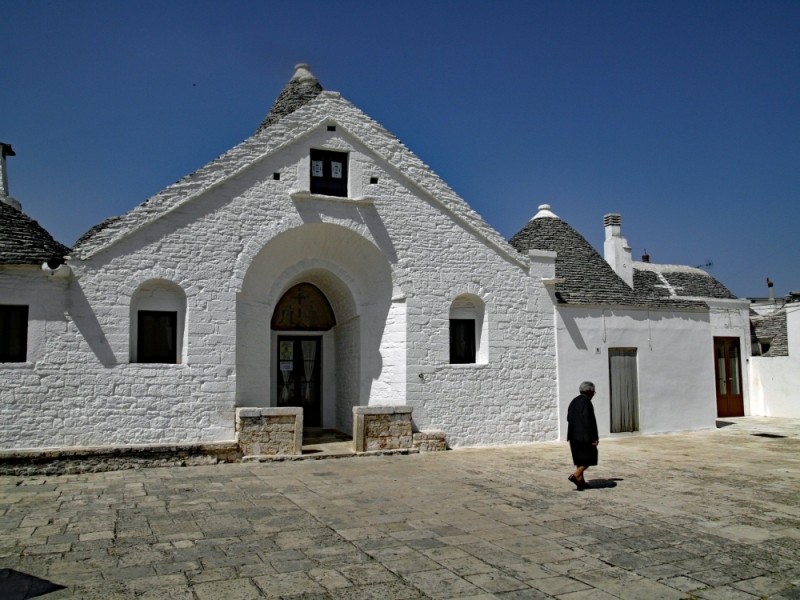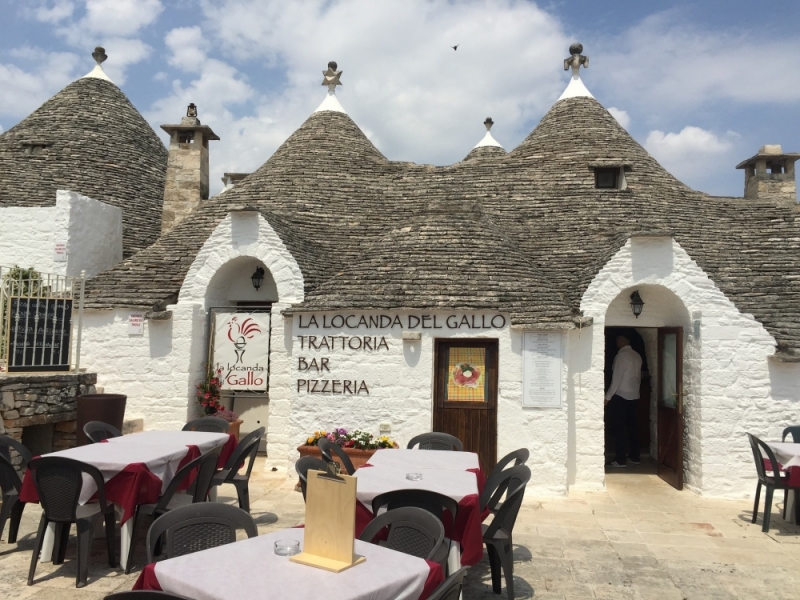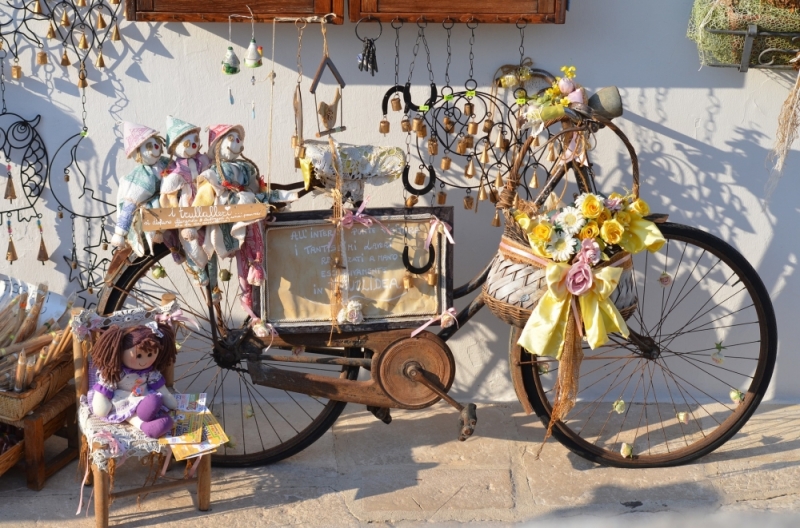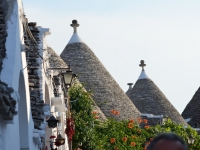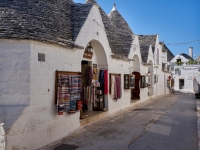The origins of Alberobello
In the heart of the Murgia, 50 kilometers from Bari, stands Alberobello, a unique village where the houses are dry-built, have a circular plan and the roofs have the shape of a cone and are called "trulli". The trulli have been the subject of numerous awards. Already in 1910 the Italian government issued a decree to elect the Monte district as a National Monument. In 1930 the Aia Piccola district was also elevated to a national monument. From 5 December 1996, as part of the 20th Session of the UNESCO World Committee, it declared: "The trulli of Alberobello" a World Heritage Site with the motivation: "exceptional typology, continuity of habitation, survival of a building culture of prehistoric origin. ..". The origin of the nucleus of Alberobello is mainly due to the powerful Count Giangirolamo II, known by historians as the Guercio delle Puglie/Guelfo because he had one eye bandaged, who, in 1635, built an inn with a refectory, tavern and oratory dedicated to the Madonna of Loreto and to the Holy Doctors. This first nucleus started urbanization with the construction of a cluster of small houses. The abundance of material, especially limestone and karst stone and calcareous sedimentary, and the count's authorization to build houses only with dry stone walls without the use of mortar, combined with the inventiveness of the locals, gave life to the Trulli. The obligation to have houses built only with dry stone was an expedient of the count to avoid paying taxes to the Spanish viceroy of the Kingdom of Naples according to the Pragmatica de Baronibus, due, until the eighteenth century, for the construction of each new inhabited center.
What see
Alberobello is a village to be known walking through its narrow streets as if we were curious children. Curious children who see strange buildings for the first time, unique in the world, which probably date back to prehistoric times. A place where the need became ingenuity, a place where, in order not to pay the heavy taxes of the time, man has devised a new way of building, creating houses that today we will call "green" because, without any kind of heating or cooling, they are warm in winter and cool in summer.
center Piazza Gian Girolamo
Start the vs. tour from the center of alberobello and that is from piazza Gian Girolamo D'Acquaviva of Aragon. Here is the roof terrace Belvedere or Terrace of Santa Lucia. From here you can enjoy a spectacular view and admire the Rione Monti from above. The Monti district is composed of 1030 trulli. These are lined up along eight irregular streets that proceed towards the top of the hill. On the top of the qcolle there is the church of Sant'Antonio da Padova , also in the shape of a trullo. Among all the 1,030 trulli to visit are the best known Trulli Siamesi , which are united on the top but with entrances from two different roads. Legend has it that once they were connected to each other, but cge that they were separated as a result of the disputed love for a girl between two brothers. For shoppers here many trulli have been converted to small shops or craft shops.
Rione AIA Piccola
In the Aia Piccola district there are 400 trulli and they are almost all inhabited. This district has the distinction of having preserved its atmosphere from an old medieval village. the trullo to visit is the "Trullo Sovrano" , a two-story trullo with a huge facade, unique of its kind. The Trullo Sovrano represents the maximum design capacity achieved for trullo buildings. Today it is a museum that can be visited for a fee, where you can admire furnished rooms and its beautiful Mediterranean garden. In the past it was called the Court of Pope Cataldo because it was owned and probably built by the family of the priest Cataldo Perta (1744-1809), who used it as his home, while in the surrounding trulli lived the employees. A curiosity: at the side of the door there were 2 peepholes: they were used both to recognize a welcome guest and to hit an attacker with a shot. Continuing, you can visit the Museum of the former territory "Casa Pezzolla" , where you can immerse yourself in the culture of the territory, discovering the main productive activities of the area and admiring the typical furnishings of a trullo of the peasant era. Casa Pezzolla is a unique architectural complex, as it is composed of 15 communicating trulli.
Parish of Sant'Antonio Padova and the Santa Lucia church
Parish Shrine of St. Anthony of Padua, in the Monti district, was built between 1926 and 1927 on the initiative of the bishop mons. Domenico Lancelotti. The singularity of the building, which has a Greek cross plan, is in the reproduction of the features of the trulli surrounding it. The conical roof typical of trulli is also found in the dome, 21 meters high, and in the other bell tower 18.30 meters. There is a relic of Saint Anthony of Padua, the statue of the same saint "Saint Anthony gives the bread to the poor" in papier-mâché by Raffaele Carrella (1877-1950) from 1927 brought to Alberobello by the priest Lippolis, the papier-mâché of Saint Rita of Cascia donated by the devout Pietro Basile, a small statue of Saint Joseph in papier-mâché and one in ceramics of the Immaculate Conception, plus in the archives the statue of the Pietà. The Church of Santa Lucia was built to house the Confraternity of the Blessed Sacrament in 1823. Since then it has undergone several renovations and since 1904 has housed a relic of St. Lucia.
Sanctuary of the Santissimi Medici
The Sanctuary of the Santi Medici, at the beginning of the seventeenth century, was simply a small chapel with an altar, where the image of the Medici saints was venerated. Starting from 1725 this small chapel began to be enlarged. In 1785 the relics of the two saints arrived from Rome and, ten years later, the temple underwent a further extension, with also a new high altar with a choir behind it. In 1881 the City Council decided to redo the façade, building it in limestone, it is marked by pilasters and columns. The protruding pediment is flanked by the statues of St. Peter and St. Paul. From the upper level start the two bell towers, whose cells end with a square pyramid roof. On the bronze portal (1975) there are bas-reliefs depicting the Beatitudes. In 1935 the temple was enriched by the chapel of the Blessed Sacrament, later adorned with a painting depicting the Last Supper by the painter Marco Sgobba (1868-1957) and two paintings by Francesco De Biase (1862-1937). The latter also painted, from 1919 to 1922, the seven works with the stories of the Saints. Doctors. The structure, in its decorative part, was finished in 1966. In the following years in the temple other works were added such as the high altar (1966) in red Tranas granite, with eight bronze panels of the pontifical sculptor Giuseppe Pirrone, and the overlying crucifix pensile (1976), by Adolfo Rollo (1898-1985). The latter also bears the ten panels (1971) depicting the Madonna and Child in the midst of Saints and Christ the King surrounded by prophets and Saints of the Old and New Testament, works that decorate the two semicircles of the arms of the church . Two paintings by Onofrio Bramante, La misericordia di Dio and Gesù Maestro (1979) complete the decoration. By the same author are the fourteen paintings of the Via Crucis and the canvas depicting the Madonna of Pompei.
Movida and Entertainment
Talking about a real nightlife here is impossible! Surely it is a place to spend a beautiful day and stop in the evening to enjoy an aperitif and an excellent dinner. During Christmas you can watch the living crib , which here, where each trullo becomes a shepherd's hut, takes on a unique charm! Also at Christmas, in the Monti district, the event " A Tavola as it once was ... takes place. Typical Dishes of the Vigil ". In every little road that climbs up to reach the Trullo Church of S. Antonio, you can taste a typical dish of the Christmas tradition of Alberobello as: "baccalè fritt", (cod fried with batter); "baccalè ca crsciaul", (salted cod with hand-made tagliatelle from grossetto which is a flour); "fcazz ca´ cpodd", (focaccia stuffed with sweet onions, olives); "tmben d´ ciuchredd e vambascioun" (timbale of wild chicory and muscari or lambascioni); "scarteddet i pettl" (typical sweets: cartellate and pettole and seasoned with vin cotto or honey). The bagpipers and the musicians sing Christmas tunes. Every September, in the Villa Donnaloja of the Monti district, the 3-day beer festival takes place, where you can sample national and foreign beers, while pizza artisans attract tourists with delicious pizza. Clearly live music cannot be missed. Also in September there is " La notte dei briganti ", a historical re-enactment, from the end "800, which takes place in the woods of the Masseria Gigante. The representation includes scenes of war between brigands and Alberobello farmers and scenes of everyday life of the time "The characters, about two hundred extras, act in costume. The event ends with a tasting of poor and typical dishes. At Easter, precisely on the evening of Good Friday, the Via Crucis takes place which, in these alleys, as for the crib living at Christmas, it takes on a unique and unforgettable character.In July, however, always here in Alberobello you can watch the historical re-enactment of the " liberation of Alberobello " from the feudal dominion. It is a sort of procession told with over 250 extras in late costumes `700, which parade through the streets of the town in a succession of historical scenes: The court, groups of middle class, groups of children, groups of common people, grandparents, groups of animals. the period of life enliven the path that ends with a tasting of the simple dishes of the represented period.
Curiosities and Advice
Curiosity: to break up the white of the trulli and the walls of the many alleys of Aberobello, residents hang vases full of colorful flowers on the walls. the white, here, given to lime, is used both to reflect the sun's rays and, therefore, keep the trulli fresh, but also as a symbol of purity. The roofs, then, composed of a dome made with exposed stones and pinnacles, are usually decorated with symbols of a spiritual, propitiatory or esoteric nature. The resident population is approximately 10,000 people and is located 428 meters above sea level.
Advice: While walking through the village of Alberobello and passing from one district to another, a stop in one of the trullo restaurants is a must, to taste the local Apulian delicacies such as orecchiette with tomato and cacioricotta (or with turnip greens, or garlic, anchovies and fried breadcrumbs) and taste the typical products of the area (mozzarella, burrata, legumes, etc). The cuisine of the "city of trulli" is simple in preparation and ingredients and still offers dishes that the farmers who gave life to the ancient village of the 16th century ate. Here the culture of food and wine is deeply rooted, with a slow-food, but above all with the use of 0 km raw materials, produced by small local companies.For those who, however, want to live a truly unique and particular experience, the advice is to spend the night sleeping in a trullo in Alberobello.
Climate
Climate: Alberobello has a Mediterranean climate with hot, dry summers and a mild winter. The best times to go to Alberobello are from May to October, when there is a pleasant temperature and little rainfall. The highest average temperature is 29°C in July and the lowest is 12°C in January.



